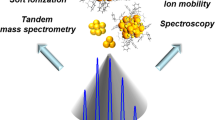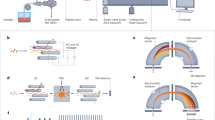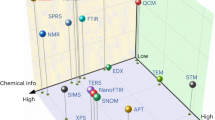Abstract
Nanostructure-initiator mass spectrometry (NIMS) is a new surface-based MS technique that uses a nanostructured surface to trap liquid ('initiator') compounds. Analyte materials adsorbed onto this 'clathrate' surface are subsequently released by laser irradiation for mass analysis. In this protocol, we describe the preparation of NIMS surfaces capable of producing low background and high-sensitivity mass spectrometric measurement using the initiator compound BisF17. Examples of analytes that adsorb to this surface are small molecules, drugs, lipids, carbohydrates and peptides. Typically, NIMS is used to analyze samples ranging from simple analytical standards and proteolytic digests to more complex samples such as tissues, cells and biofluids. Critical experimental considerations of NIMS are described. Specifically, NIMS sensitivity is examined as a function of pre-etch cleaning treatment, etching current density, etching time, initiator composition, sample concentration, sample deposition method and laser fluence. Typically, NIMS surface preparation can be completed in less than 2 h. Subsequent sample preparation requires 1–5 min, depending on sample deposition method. Mass spectrometric data acquisition typically takes 1–30 s per sample.
This is a preview of subscription content, access via your institution
Access options
Subscribe to this journal
Receive 12 print issues and online access
$259.00 per year
only $21.58 per issue
Buy this article
- Purchase on Springer Link
- Instant access to full article PDF
Prices may be subject to local taxes which are calculated during checkout








Similar content being viewed by others
References
Peterson, D.S. Matrix-free methods for laser desorption/ionization mass spectrometry. Mass Spectrom. Rev. 26, 19–34 (2007).
Wei, J., Buriak, J.M. & Siuzdak, G. Desorption-ionization mass spectrometry on porous silicon. Nature 399, 243–246 (1999).
Nayak, R. & Knapp, D.R. Effects of thin-film structural parameters on laser desorption/ionization from porous alumina. Anal. Chem. 79, 4950–4956 (2007).
Wada, Y., Yanagishita, T. & Masuda, H. Ordered porous alumina geometries and surface metals for surface-assisted laser desorption/ionization of biomolecules: possible mechanistic implications of metal surface melting. Anal. Chem. 79, 9122–9127 (2007).
Wen, X.J., Dagan, S. & Wysocki, V.H. Small-molecule analysis with silicon-nanoparticle-assisted laser desorption/ionization mass spectrometry. Anal. Chem. 79, 434–444 (2007).
McLean, J.A., Stumpo, K.A. & Russell, D.H. Size-selected (2–10 nm) gold nanoparticles for matrix assisted laser desorption ionization of peptides. J. Am. Chem. Soc. 127, 5304–5305 (2005).
Seino, T. et al. Matrix-free laser desorption/ionization-mass spectrometry using self-assembled germanium nanodots. Anal. Chem. 79, 4827–4832 (2007).
Go, E.P. et al. Desorption/ionization on silicon nanowires. Anal. Chem. 77, 1641–1646 (2005).
Xu, S.Y. et al. Carbon nanotubes as assisted matrix for laser desorption/ionization time-of-flight mass spectrometry. Anal. Chem. 75, 6191–6195 (2003).
Ren, S.F., Zhang, L., Cheng, Z.H. & Guo, Y.L. Immobilized carbon nanotubes as matrix for MALDI-TOF-MS analysis: Applications to neutral small carbohydrates. J. Am. Soc. Mass Spectrom. 16, 333–339 (2005).
Northen, T.R. et al. Clathrate nanostructures for mass spectrometry. Nature 449, 1033 (2007).
Acknowledgements
This project was funded by DOE GTL Grants (MAGGIE and GeneMAP). This work was supported by the US Department of Energy Office of Science under contract no. DE-AC02-05CH11231 through the Genomics: GTL Research Program.
Author information
Authors and Affiliations
Corresponding author
Rights and permissions
About this article
Cite this article
Woo, HK., Northen, T., Yanes, O. et al. Nanostructure-initiator mass spectrometry: a protocol for preparing and applying NIMS surfaces for high-sensitivity mass analysis. Nat Protoc 3, 1341–1349 (2008). https://doi.org/10.1038/nprot.2008.110
Published:
Issue Date:
DOI: https://doi.org/10.1038/nprot.2008.110
This article is cited by
-
Plasmonic polydopamine-modified TiO2 nanotube substrates for surface-assisted laser desorption/ionization mass spectrometry imaging
Nano Research (2023)
-
A multiplexed nanostructure-initiator mass spectrometry (NIMS) assay for simultaneously detecting glycosyl hydrolase and lignin modifying enzyme activities
Scientific Reports (2021)
-
Biological tissue sample preparation for time-of-flight secondary ion mass spectrometry (ToF–SIMS) imaging
Nano Convergence (2018)
-
Large-Area Graphene Films as Target Surfaces for Highly Reproducible Matrix-Assisted Laser Desorption Ionization Suitable for Quantitative Mass Spectrometry
Journal of the American Society for Mass Spectrometry (2018)
-
Imaging of Endogenous Metabolites of Plant Leaves by Mass Spectrometry Based on Laser Activated Electron Tunneling
Scientific Reports (2016)
Comments
By submitting a comment you agree to abide by our Terms and Community Guidelines. If you find something abusive or that does not comply with our terms or guidelines please flag it as inappropriate.



